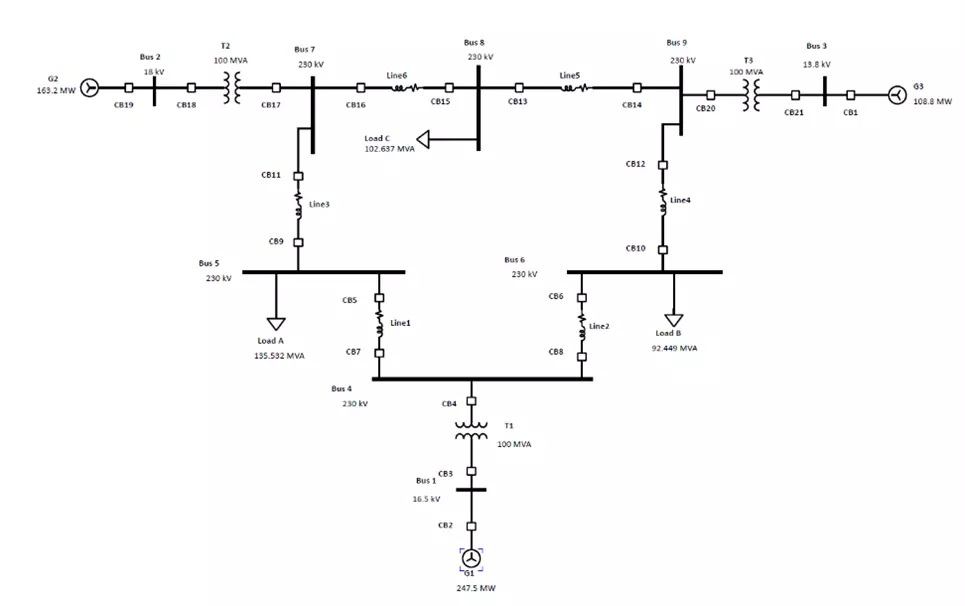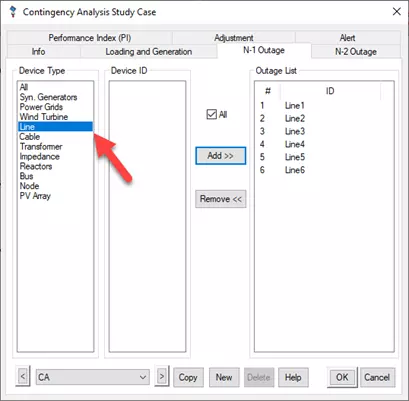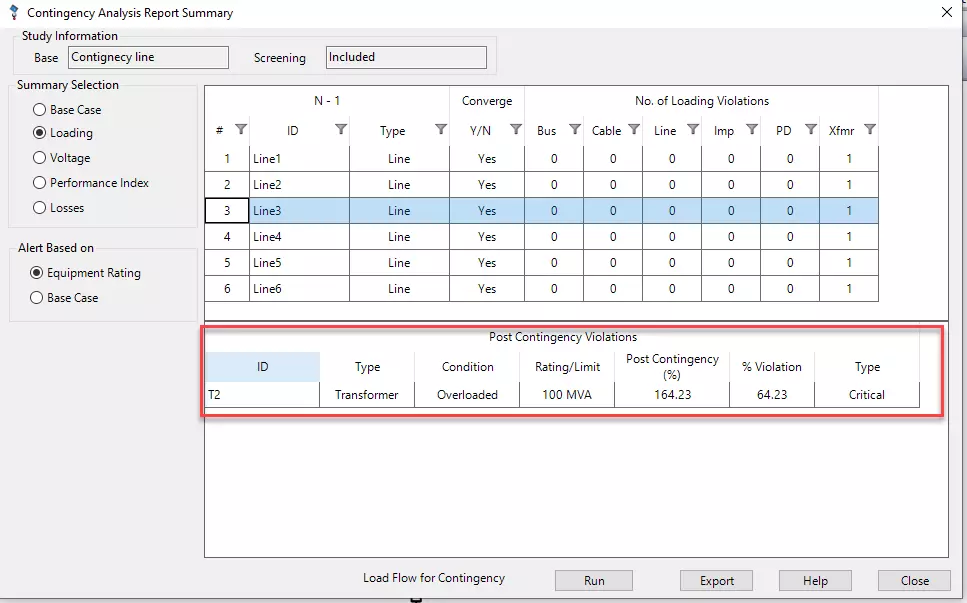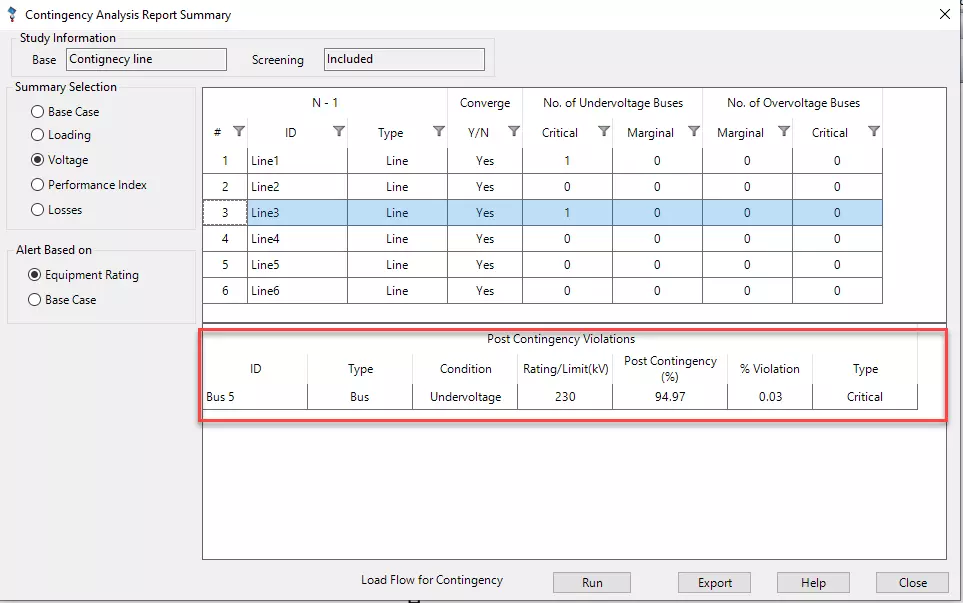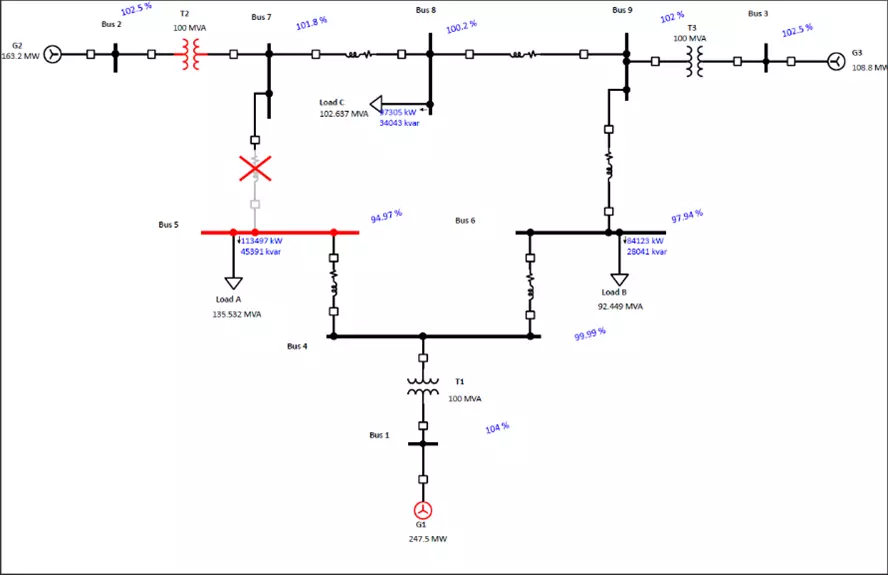Contingency Analysis Using Power System Studies

Contingency is defined as a foreseen or unforeseen event that happens in the power system for a certain period of time , which refers to the loss or outage of one or more power system components. Contingency analysis provides an indicator of the possible state of the power system at the time of an equipment or component failure in the power system. It functions primarily as a software program that is run in a power management system, simulating a hypothetical test on a set of instances that would result in power flow, voltage, or reactive power violations in the system. Hence, contingency analysis is performed on a list of potential outages. The contingency ranking approach is used to identify these cases and rate them according to their severity.
Contingency Analysis
Contingency creation, selection, and evaluation are the three main divisions of contingency analysis. Many studies have focused on contingency selection, primarily with the goal of reducing the extensive list of contingencies by choosing those outages with serious limit violations. The individual outages are then evaluated using load flow. The activity will continue until there have been no post-contingency violations.
- Contingency Creation: It is the first stage of the contingency analysis process. It consists of every possible scenario of contingency that might occur in a power system. This process consists of making contingency lists.
- Contingency Selection: The process of determining severe contingencies from anything that might lead to a violation of bus voltages and power is the second stage of contingency analysis. The least severe contingency is rejected in this approach, and the most severe disruptions are considered instead. The performance index has been utilized in this procedure to identify the worst ones.
- Contingency Evaluation: This is the final stage of the contingency analysis process, where the contingencies selected in the previous step are examined in detail. In this phase, full load flow & power system studies are carried out to determine how the system actually behaves after each critical outage. The goal is to assess whether the post-contingency operating conditions lead to any violations in power flow, bus voltages, or reactive power limits. By simulating the system response to each selected disturbance, operators can identify which cases produce unacceptable conditions and require corrective action. This step ultimately confirms the true severity of each contingency and ensures that the system remains secure under a wide range of potential failures.
Most Common Types Of Contingencies In Power System
There are several contingencies scenarios, but the most common ones are listed below:
- Loss of transmission component
- Loss of generating unit
- Equipment failure
We recently published a blog on The Importance of Equipment Maintenance Plan for Electrical Power Systems . Checked it out to grasp the information available in this blog.
Various Operating State In Power System:
Contingency analysis involves the power system to operate into four operating states:
- Pre Contingency: In this condition, the power system is in prior to any contingency. It is the most cost-effective option, but it may not be the most secure.
- Post Contingency: The status of the power system after a contingency has occurred; it is considered that this condition has a security violation, such as a line or transformer over its flow limit, or a bus voltage exceeding its limit.
- Security Dispatch: It is the condition of the system with no contingency but with operational parameter modifications to account for security violation.
- Secure Post-Contingency: This is the state in which the contingency is corrected and applied to the base operating condition.
Performance Index:
The contingencies are chosen by computing Performance Metrics, a kind of severity indices (PI). These indices are computed in an offline mode for each contingency using the standard power flow techniques. The scenarios are prioritized according to the values received, starting with the contingency with the greatest PI value. After then, the analysis is carried out beginning with the contingency that is listed first and continued until no severe contingencies are found.
There are two kind of performance index which are of great use, these are Active power performance index (PIP) and Reactive power performance index (PIV)
- Active power performance index: It identifies the power overflows through the transmission lines.
- Reactive power performance index: It corresponds to bus voltage magnitude violations.
N-1 Contingency
A prominent method for determining how secure power systems are is the N-1 contingency. This criteria states that a planned power system must be capable of handling any single component failure while supporting all of the system's demands without violating any of the other component limitations. When several components fail at once, the N-1 contingency might not be enough.
N-K Contingency
The N-K contingency analysis considers the failure of many components. A power system should be able to endure K number (2, 3) of component failures simultaneously according to the N-K contingency.
N-1-1 Contingency
N-1-1 contingency is defined as a single fault followed by another fault occurring after some time delay.
Load Flow Study To Perform Contingency Analysis
Contingency analysis involves power system studies that assess the effects of equipment outages on the system. The analysis is typically performed by conducting load flow or short circuit studies after simulating the removal of system components such as transformers, buses, and lines. In this context, load flow studies are commonly preferred over short circuit studies for contingency analysis. Load flow studies are ideal for evaluating the stability of the overall system, providing a comprehensive understanding of whether the system would remain stable given a specific contingency. On the other hand, short circuit studies are primarily utilized for protection and coordination purposes. These studies are conducted after ensuring system stability through load flow analysis, allowing for a more focused examination of protection measures and coordination.
ETAP Simulation
Consider IEEE 9 bus system. The system as shown in figure b consist of a slack bus numbered 1. Whereas all remaining buses are load bus. Fig (e) shows the state of the system prior to any contingency.
In order to run contingency analysis on ETAP, from below shown module bar in (Fig f), select contingency analysis. Then click on the briefcase as shown in fig (g).
After clicking the below mentioned case study will appear in a pop-up screen. From the case study select the type of contingency you want to evaluate. Then click on the ADD button as shown below. Here line contingency has been selected.
Then click on the following tab.
The table mentioned below shows the result of all the line outages and their effect on the system. Of all the line contingencies, line 3 is the most severe line outage based on its value of active power index which is 4.07 i.e. highest among all.
Outage of line 3 results in 164.23 % overloading of T2 i.e., exceeding from normal operating condition. Hence, resulting in critical condition.
On moving towards voltage violation, it can be seen in fig (h). that line 3 outage also resulted in the undervoltage condition on bus 5.
Hence the combined result of line 3 outage can be seen in fig (i). i.e. overloading of transformer T2 and under voltage condition on Bus 5.
Contingency analysis study helps to strengthen the initial basic plan and judge the state of power system if any equipment gets outage from the system. So, by forecasting the effect of any outage, the operator come to know the prior action what should be done for the particular outage. Hence by applying correct remedial action scheme as discussed above, limit violations can be removed effectively from the system.
Contact us today to discuss your requirements and let us help you achieve electrical system designs that are reliable, cost-effective, and compliant with industry standards. Together, we can pave the way for a safer and more efficient electrical future.
AllumiaX is a licensed Engineering company headquartered in Seattle, Washington USA. We work with sub-contractors to deliver various Power System Engineering studies including DC arc flash, DC short circuit, and more. Get in touch with us or Request a Quote.

Stay Sharp & Join our Mailing List!
Subscribe to Allumiax Blog for updates on power system studies, tips, guides and insights on electrical engineering from industry leaders.

